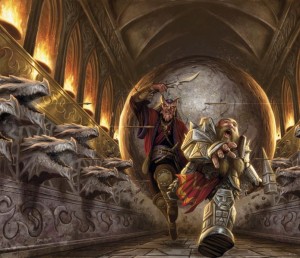On Friday we comb through our extensive archives to find an older article that we feel deserves another look. From September 27, 2011, Dungeon’s Master once again presents: Traps – Challenge the Players and the Characters.
Sometimes it’s difficult to separate what the player knows from what the character knows. The reverse can also be true, in a manner of speaking. There are going to be times when the character would have certain knowledge or information that the player would never ever know themselves. This is just part of how the game works. You have to accept it if you’re going to play RPGs.
When it comes to combat there’s rarely any concern between the separation of player and character knowledge. Combat has clearly defined mechanics that involve a lot of dice. It doesn’t matter that I’m not proficient with a great sword, if my PC has the appropriate proficiency then the mechanics account for that and I keep on rolling my dice.
Where this becomes more troublesome is outside of combat. During the non-combat parts of role-playing games players have to be more mindful of separating what they can do from what their character can do. This situation can be troublesome when playing characters with exceptionally high ability scores or playing characters with exceptionally low ability scores.

